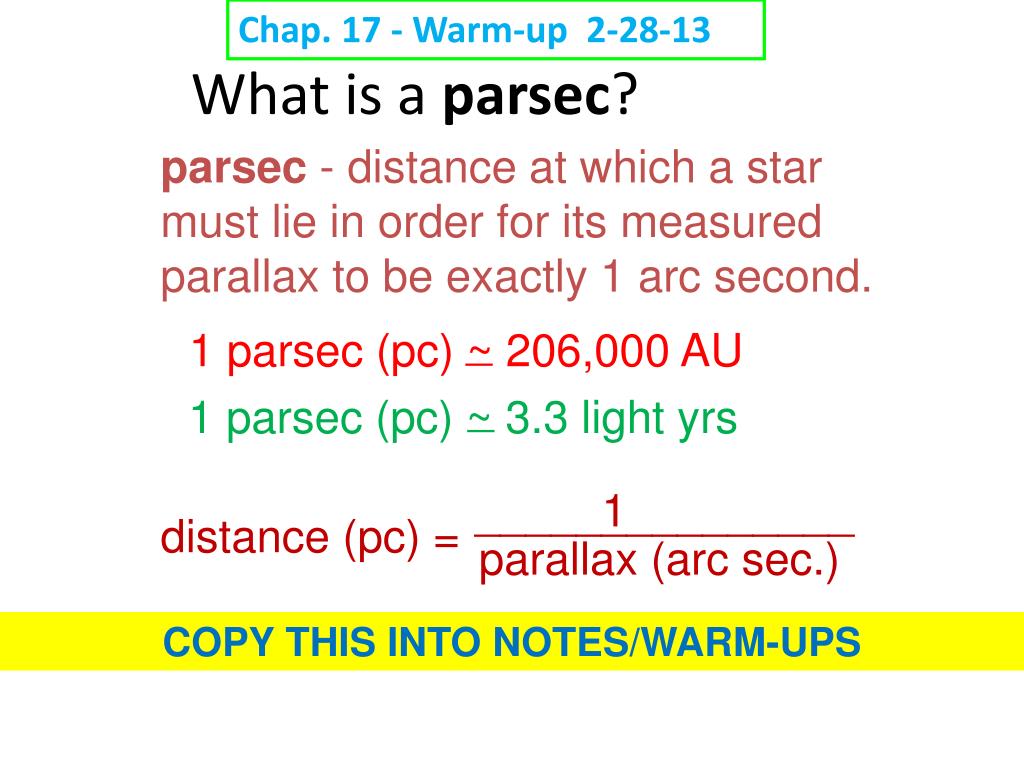
It is approximately 3.1 centimetres - just a little over an inch.CONVERT : between other length measuring units - complete list.


One kiloparsec, abbreviated "kpc", is one thousand parsecs, or 3,261 light years. The Oort cloud is approximately 0.6 parsec in diameter.ĭistances measured in parsecs include distances between nearby stars, such as those in the same spiral arm or globular cluster.It took Voyager 27 years to cover that distance. The most distant space probe, Voyager 1, was 4.6 × 10 −4 parsecs away from Earth in September 2004.One astronomical unit (the distance from the Sun to the Earth) is 4.85 × 10 −6 parsecs.The ESA's GAIA satellite, due to be launched in mid-2012, will be of sufficiently high astrometric precision to measure stellar distances to within 10% accuracy as far as the Galactic Center about 8 kpc away in the Sagittarius constellation.ĭistances in parsecs Distances less than a parsecĭistances measured in fractions of a parsec usually involve objects within a star system. However, the mission's funding was withdrawn by NASA in January 2002. NASA's FAME satellite was due to be launched in 2004, to measure parallaxes for about 40 million stars with sufficient precision to measure stellar distances of up to 2000 pc. Because of the extremely small scale of parallactic shifts, ground-based parallax methods provide reliable measurements of stellar distances of no more than 325 light-years, or about 100 parsecs, corresponding to parallaxes of no less than 0.01 arcsecond, or 10 mas (milliarcsecond).īetween 19 the Hipparcos satellite, launched by the European Space Agency (ESA) in 1989, measured parallaxes for about 100,000 stars, with a precision of about 0.97 mas, and obtained accurate measurements for stellar distances of around 1000 pc. The closest star to the Earth (having the largest measured parallax) is Proxima Centauri with a parallax of 0.772 arcseconds it is thus 1.295 parsecs, or 4.225 light-years, away from us. There is no star whose parallax is more than 1 arcsecond. Newspapers and popular science magazines prefer a more intuitive unit, the light year. Since the parallax method is the fundamental calibration step for distance determination in astrophysics, its unit of choice, the parsec, is the most used unit of distance in scholarly astronomical publications. However, Herbert Hall Turner's suggestion, parsec, was eventually adopted. He himself proposed the name astron, while Carl Charlier had suggested siriometer. Though it had probably been used before, the term parsec was first mentioned in an astronomical publication in 1913, when Frank Watson Dyson expressed his concern for the need of a name for that unit of distance.

The parsec follows naturally from this method, since the distance (in parsecs) is simply the reciprocal of the parallax angle (in arcseconds). The first direct measurements of an object at interstellar distances (of the star 61 Cygni, by Friedrich Wilhelm Bessel in 1838) were done using trigonometry using the width of the Earth's orbit as a baseline.
#LENGTH PARSEC UNIT HOW TO#
4 How to calculate the value of a parsec.


 0 kommentar(er)
0 kommentar(er)
